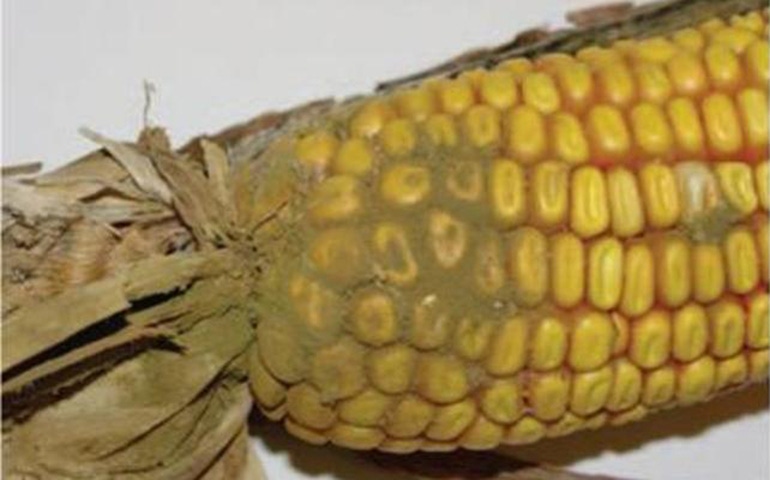The presence of mold in corn does not guarantee that toxins are present, but it is impossible to have toxins present if there is no mold.
April 18, 2019

By John F. Patience, Stacie Gould and Jesus Acosta, Iowa State University
Typically, mycotoxins are not a problem everywhere every year, but it is not uncommon for them to be a problem somewhere every year.
What are we talking about when we mention the word mycotoxins? Typically, in the Corn Belt, we are referring to deoxynivalenol, also known as vomitoxin, the family of toxins known as fumonisins, and zearalenone. Occasionally we might also be dealing with ochratoxin and T-2 toxin, and in dry years, possibly aflatoxin. Each of these presents its own set of problems to pork producers, typically resulting in reduced growth performance and/or reduce reproductive performance.
Various people or institutions have provided guidelines of the upper limit of these toxins in pig diets. As useful as these guidelines are, they are not absolute. Levels lower than published limits might cause production problems and in some cases, higher levels appear to have no effect. This is definitely not an exact science. Nonetheless, we need these guidelines as a starting point for how we deal with the various toxins. Typically, we like to keep DON below 1 part per million, if possible, although somewhat higher levels have sometimes shown no effect. The often-quoted maximum for total fumonisins is 10 ppm, for ochratoxin is 0.2 ppm, for T-2 toxin is 2 ppm and for zearalenone is 1 ppm for weanling pigs and 3 ppm for growing pigs. Typically, nursery pigs are more susceptible than growing and finishing pigs. We think it is important to strive for no toxins in diets intended for the breeding herd, and this includes developing gilts. The tolerances for toxins in sow diets have typically not been supported by large scale studies, so we recommend extreme caution.
At this juncture, it is important to note that the presence of mold in corn does not guarantee that toxins are present, but it is impossible to have toxins present if there is no mold. Having said this, moldy corn is not without problems; the growth of mold in the kernel utilizes nutrients and reduces the feeding value for pigs. Interestingly, in a study we conducted a number of years ago, the best predictor of energy in moldy corn was the proportion of broken kernels; as this increased, energy values decreased.
One of the key problems with predicting the performance of pigs fed corn containing mycotoxins is the presence of more than one toxin. It is difficult enough to predict the pig’s response to DON, for example, but what happens when fumonisins or zearalenone are also present. It is a difficult topic for research due to the endless combinations of toxins and levels of toxins. However, the results of two recent studies at Iowa State University might be helpful.
The first experiment was conducted in finishing pigs. The positive control diet contained very low levels of toxins: 0.1 ppm DON, 1.0 ppm total fumonisins and no detectable amount of zearalenone. The contaminated diet, however, contained 1.8 ppm DON, 1.0 ppm fumonisins and 1.9 ppm zearalenone. Thus, both DON and zearalenone were present in quantities that by themselves would be borderline acceptable for growing pigs. All pigs started with an average weight of about 160 pounds. The pigs fed the positive control ended the 28-day study weighing 227 pounds while the pigs fed the diet containing mycotoxins weighed only 193 pounds, a difference of 34 pounds. Table 1 summarizes the results; all differences between treatments were statistically significant (P < 0.01). It is clear that this combination of toxins caused a 9% to 52% reduction in performance, greater than we would have expected from each individual toxin alone. This experiment demonstrated that combinations of toxins can affect pig performance much more than what an individual mycotoxin might do. This, of course, makes sense.

A second recent experiment was carried out in nursery pigs, weaned at approximately 3 weeks of age and weighing on average 14.1 pounds. The positive control diet was prepared using corn that contained less than 0.1 ppm DON, while the contaminated diet was manufactured using corn containing 3.2 ppm DON. Thus the final diet contained 1.7 ppm DON. The results of this study are presented in Table 2. The differences between treatments were not statistically significant.

The nursery study was a much simpler study and for a shorter period of time than the finisher study above. However, nursery pigs are considered to be more susceptible to mycotoxins such as DON than older pigs. Yet, 1.7 ppm DON had little or no impact on nursery pig performance.
It is clear that much more research is required to fully understand acceptable and unacceptable levels of the various toxins that pork producers encounter. There is also a great need for more research on combinations of mycotoxins, and even what the mold itself does to the nutritive value of the corn.
Nonetheless, these two studies provide additional information on finishing pig and nursery pig responses to mycotoxins, and thus hopefully assist producers and their nutritionists in making decisions on the use of contaminated corn on their farm.
Sources: John F. Patience, Stacie Gould and Jesus Acosta, Iowa State University, who are solely responsible for the information provided, and wholly owns the information. Informa Business Media and all its subsidiaries are not responsible for any of the content contained in this information asset.
You May Also Like



